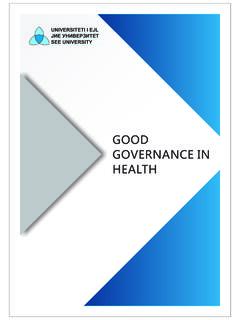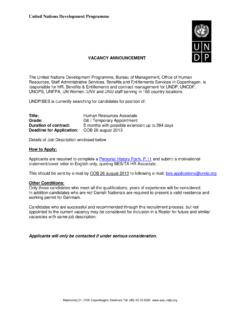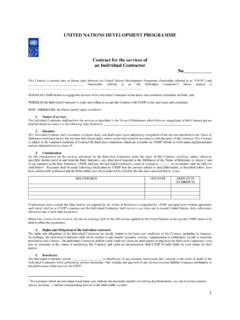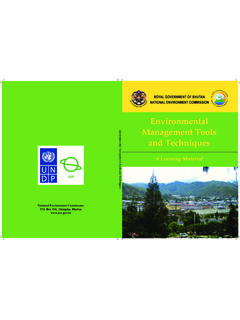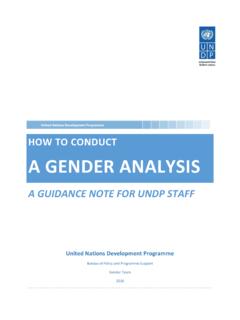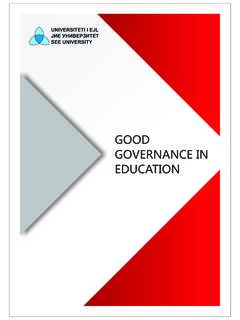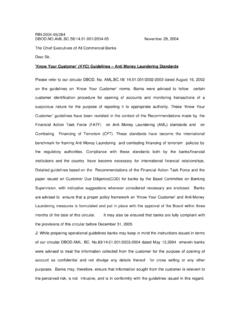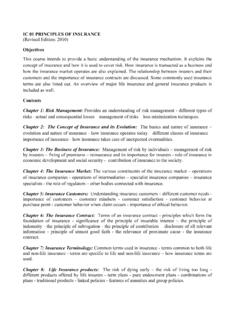Transcription of Financial Literacy Book 2012 - United Nations Development ...
1 Financial LITERACYAS A TOOLFOR Financial INCLUSIONANDCLIENT PROTECTIONii Special Thanks and Acknowledgements Sincere acknowledgements are due to the authors and institutions who have undertaken studies and to all those Microfinance enthusiasts, specialists and experts who have participated in the two e-discussions initiated by the Microfinance Community, Solution Exchange, United Nations Development Programme (UNDP) india on whose resources and data this compilation has been made possible. Acknowledgements are due to: BASICS Limited, Hyderabad, Andhra Pradesh, india Prof. RajanishDass, Indian Institute of Management, Ahmedabad, Gujarat, india Mr. Gopala Krishna Ayitam, Agri Biz india , Hyderabad, Andhra Pradesh, india This work is a product of several studies both commissioned by UNDP on its own and with partners as also with external references and experiences.
2 The findings, interpretations and conclusions expressed in this work need not necessarily reflect the views of the UNDP, its officers or the governments where the programmes are undertaken. Peer Review and Support Prema Gera Assistant Country Director & Head, Poverty Unit, UNDP india Ratnesh Programme Analyst UNDP india Conceptualization and Structure of Report Navin Anand Resource Person and ModeratorMicrofinance Community of Practice Consolidation and Writing of Report HEMANTHA KUMAR PAMARTHY iii AUTHOR S NOTE Whenever we think of Financial Inclusion (FI), we should be thinking of those tribes or ethnic minorities in the world who have not been exposed to the worldly matters and who may not understand the concept of money , let alone finance. Many of the disadvantaged people across the world are like these tribes; with one difference though, in that they need money , but may have very limited knowledge of using the money .
3 Literacy and Financial Literacy (FL), thus form the most integral part of the Financial Inclusion as, without knowing the fundamentals, the disadvantaged people can continue to be innocent, gullible and in some cases unknowingly irresponsible too. One of the primary objectives of Financial Literacy would be to help the disadvantaged practice thrift and induce them to save, access credit, use the funds to find a better livelihood, earn income and thus join the mainstream from exclusion. Many agencies in the world, as also in our country, are working towards this end but there is a need to pause and take stock whether the intended methods are in the right direction or a midway course correction is required. Mr. Sameer Kochhar of SKOCH Foundation, who has been working relentlessly towards the Financial Inclusion, in his book Speeding Financial Inclusion mentioned that Financial Inclusion unfortunately has become synonymous with the mere opening of bank accounts and reduced to creating channels for Electronic Benefit Transfer (EBT), where-as it should be much more.
4 UNDP-NABARD undertookin-depth studies in seven focusstates of india and this report is a compilation and summing up of these reports with additional inputs, wherever needed and possible. My sincere thanks to Ms. Prema Gera, Assistant Country Director & Head, Poverty Unit, UNDP, Mr. Ratnesh, Programme Analyst, UNDP and Dr. Navin Anand, Resource Person andModerator, Microfinance Community-Solution Exchange of UNDP and other members of UNDP,who reposed confidence in me to compile and write this report. I earnestly hope that their confidence is not misplaced and that this report would become worthy of their trust to become a useful document in the Financial Inclusion of india . Hemantha Kumar Pamarthy 15thNovember, 2012 iv PREFACE In the war against poverty, Financial Inclusion (FI) has emerged as a priority for policy makers and regulators in over 60 developing countriesa across the globe.
5 An increasing number of countries have introduced or introducing holistic approaches and methods to improve access to finance. A Financial Inclusion Experts Group (FIEG) was created, to expandaccess to finance for household consumers and micro, small and medium sized enterprises. The group has developed nine Principles for Innovative Financial Inclusion viz., Leadership, diversity, innovation, protection, empowerment, cooperation, knowledge, proportionality and framework, from experiences and lessons learned from policymakers across the world, which have been endorsed during the Toronto Summit in June, 2010. In india , though the activity of Financial inclusion started as early as 1950, from the year 2005 onwards Financial inclusion has been considered a Policy Priority for reserve bank of india (RBI), india s central bank , which has given several directions and guidelines during the past one decade.
6 It looks at FI as an effective tool for inclusive growth ensuring equality of opportunity for all. RBI has been focusing on facilitating a process of making available a range of appropriate Financial products and services to the underprivileged sections of the Indian Society at an affordable costb. Keeping a credit delivery focus, RBI has given guidelines to banks in the country encouraging Financial inclusion such as implementation through the banks and dis-incentivising those banks which are not responsive to the community including the underprivileged. Banks have been urged to align their existing practices with the objectives of Financial inclusion. From 2006 more enabling environment was being created with opening No-Frill Accounts, Overdraft facility for Saving bank Accounts, Relaxed Know Your Customer (KYC) norms, permitting the banks to use the services of intermediaries-Business Correspondents (BC) and Business Facilitators (BF).
7 ---------------------------------------- a CGAP publication Implementing Client Protection Principles a Technical Guide for Investors by Sarah Forster, Estelle Lahaye and Kate McKee, September, 2009. b A Presentation titled Financial Inclusion, RBI Initiatives by Dr. K. C. Chakrabarty, Deputy Governor, reserve bank of india , at National Seminar on Launching a National Initiative for Financial Inclusion at New Delhi on 18th September, 2009. Extracted on 11th November, 2012 from PREFACE In the war against poverty, Financial Inclusion (FI) has emerged as a priority for policy makers and regulators in over 60 developing countriesa across the globe.
8 An increasing number of countries have introduced or introducing holistic approaches and methods to improve access to finance. A Financial Inclusion Experts Group (FIEG) was created, to expandaccess to finance for household consumers and micro, small and medium sized enterprises. The group has developed nine Principles for Innovative Financial Inclusion viz., Leadership, diversity, innovation, protection, empowerment, cooperation, knowledge, proportionality and framework, from experiences and lessons learned from policymakers across the world, which have been endorsed during the Toronto Summit in June, 2010. In india , though the activity of Financial inclusion started as early as 1950, from the year 2005 onwards Financial inclusion has been considered a Policy Priority for reserve bank of india (RBI), india s central bank , which has given several directions and guidelines during the past one decade.
9 It looks at FI as an effective tool for inclusive growth ensuring equality of opportunity for all. RBI has been focusing on facilitating a process of making available a range of appropriate Financial products and services to the underprivileged sections of the Indian Society at an affordable costb. Keeping a credit delivery focus, RBI has given guidelines to banks in the country encouraging Financial inclusion such as implementation through the banks and dis-incentivising those banks which are not responsive to the community including the underprivileged. Banks have been urged to align their existing practices with the objectives of Financial inclusion. From 2006 more enabling environment was being created with opening No-Frill Accounts, Overdraft facility for Saving bank Accounts, Relaxed Know Your Customer (KYC) norms, permitting the banks to use the services of intermediaries-Business Correspondents (BC) and Business Facilitators (BF).
10 ---------------------------------------- a CGAP publication Implementing Client Protection Principles a Technical Guide for Investors by Sarah Forster, Estelle Lahaye and Kate McKee, September, 2009. b A Presentation titled Financial Inclusion, RBI Initiatives by Dr. K. C. Chakrabarty, Deputy Governor, reserve bank of india , at National Seminar on Launching a National Initiative for Financial Inclusion at New Delhi on 18th September, 2009. Extracted on 11th November, 2012 from v A working group was constituted to examine the experience of the BCs & BFs, keeping an eye on the regulatory and supervisory frame work and consumer protection issues, Kisan Credit Cards (KCC) /General Credit Cards(GCC) guidelines , Liberal bank branch expansion, allowing Regional Rural Banks (RRBs) and Co-operative Banks to sell Insurance and other Financial products also, other than savings, introducing technology products such as pre-paid cards and services such as Mobile Banking.


